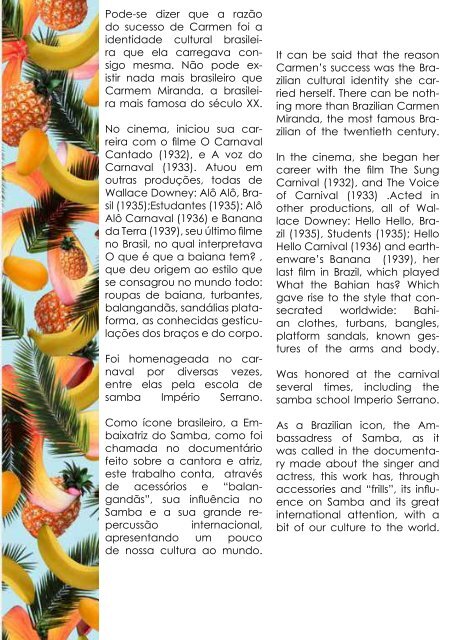Create successful ePaper yourself
Turn your PDF publications into a flip-book with our unique Google optimized e-Paper software.
Pode-se dizer que a razão<br />
do sucesso de Carmen foi a<br />
identidade cultural brasileira<br />
que ela carregava consigo<br />
mesma. Não pode existir<br />
nada mais brasileiro que<br />
Carmem Miranda, a brasileira<br />
mais famosa do século XX.<br />
No cinema, iniciou sua carreira<br />
com o filme O Carnaval<br />
Cantado (1932), e A voz do<br />
Carnaval (1933). Atuou em<br />
outras produções, todas de<br />
Wallace Downey: Alô Alô, Brasil<br />
(1935);Estudantes (1935); Alô<br />
Alô Carnaval (1936) e Banana<br />
da Terra (1939), seu último filme<br />
no Brasil, no qual interpretava<br />
O que é que a baiana tem? ,<br />
que deu origem ao estilo que<br />
se consagrou no mundo todo:<br />
roupas de baiana, turbantes,<br />
balangandãs, sandálias plataforma,<br />
as conhecidas gesticulações<br />
dos braços e do corpo.<br />
Foi homenageada no carnaval<br />
por diversas vezes,<br />
entre elas pela escola de<br />
samba Império Serrano.<br />
Como ícone brasileiro, a Embaixatriz<br />
do Samba, como foi<br />
chamada no documentário<br />
feito sobre a cantora e atriz,<br />
este trabalho conta, através<br />
de acessórios e “balangandãs”,<br />
sua influência no<br />
Samba e a sua grande repercussão<br />
internacional,<br />
apresentando um pouco<br />
de nossa cultura ao mundo.<br />
It can be said that the reason<br />
Carmen’s success was the Brazilian<br />
cultural identity she carried<br />
herself. There can be nothing<br />
more than Brazilian Carmen<br />
Miranda, the most famous Brazilian<br />
of the twentieth century.<br />
In the cinema, she began her<br />
career with the film The Sung<br />
Carnival (1932), and The Voice<br />
of Carnival (1933) .Acted in<br />
other productions, all of Wallace<br />
Downey: Hello Hello, Brazil<br />
(1935), Students (1935); Hello<br />
Hello Carnival (1936) and earthenware’s<br />
Banana (1939), her<br />
last film in Brazil, which played<br />
What the Bahian has? Which<br />
gave rise to the style that consecrated<br />
worldwide: Bahian<br />
clothes, turbans, bangles,<br />
platform sandals, known gestures<br />
of the arms and body.<br />
Was honored at the carnival<br />
several times, including the<br />
samba school Imperio Serrano.<br />
As a Brazilian icon, the Ambassadress<br />
of Samba, as it<br />
was called in the documentary<br />
made about the singer and<br />
actress, this work has, through<br />
accessories and “frills”, its influence<br />
on Samba and its great<br />
international attention, with a<br />
bit of our culture to the world.



